Chapter 2 - Roots of Colonization
Total Video: 1.56
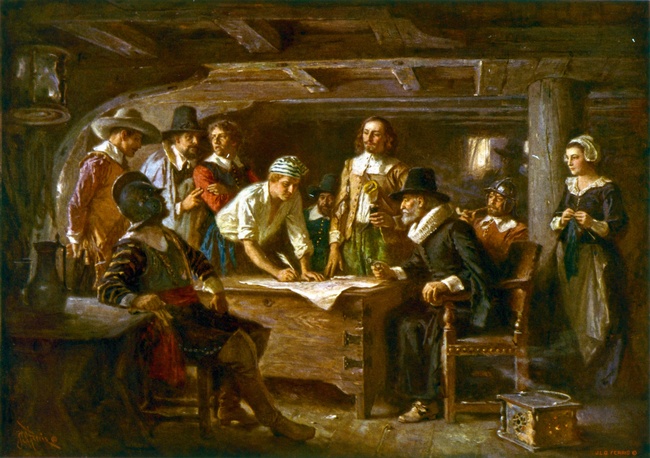
Introduction
European exploration and colonization resulted from a combination of forces, including, war, faith, and markets. When the Roman Empire divided and moved its capital to Constantinople (modern day Istanbul) in 330 AD, this marked the end of the Roman and beginning of the Byzantine period. Officially “Christian,” the Byzantine Empire withdrew from the western Mediterranean and consolidated its power in the eastern Mediterranean, controlling and Christianizing, Egypt, Palestine, and Asia Minor.
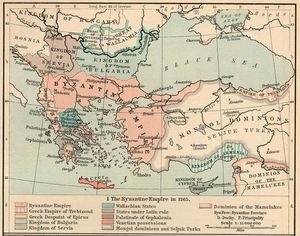
In 630 AD a new power, “Islam,” arose and began to encroach upon the Byzantine sphere of influence. By the end of the first millennium the Byzantine Christians had been pushed out of the holy lands and back to the very gates of Constantinople itself. Islam swept over North Africa, the Holy Lands and Southeastern Europe—forcing the choice of conversion, taxation or death upon its mostly Christian inhabitants.
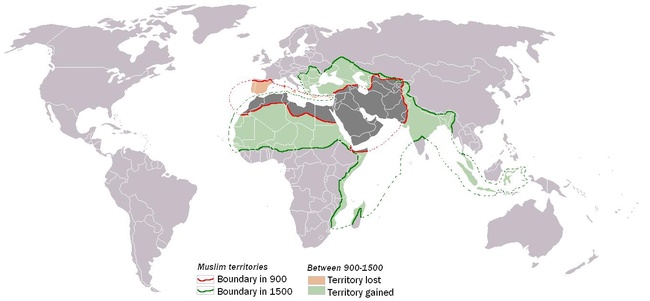
Crusade
This turn of events prompted the Byzantine Emperor, Alexius Comnenus, to call upon his rival—the Pope—in Rome for help. A series of crusades developed over the next few centuries in which Catholic Europeans marched, sailed and otherwise traveled to the holy lands to free their Greek Orthodox cousins from the “infidel” Muslims. These on-again, off-again wars resulted in cultural warfare between Muslims and Christians. Perhaps of greater consequence, however, was the trade that resulted from this mix of cultures.
( 3.02 ) Video “Ancient History”(https://ensemble.nmc.edu/Watch/Wr8z6NMt)
Trade
With such a tangle of cultures in the holy lands (Greek Orthodox, Catholics and Muslims), an exchange of products and ideas was bound to result. During periods of peace, Muslims became middlemen between Europeans and the far eastern trade goods that Europeans so desired. Desert trade routes like the Silk Road were plied by Arab traders who brought Chinese goods to European merchants. Catholic Europeans, of course, were often loath to trade through Muslim Arabs and hoped to find a sea route to China and cut out the Muslim middleman altogether. Such a route was found and dominated by the Portuguese in the 1400s. It was so fraught with peril, however, (especially at the southern tip of Africa) that it was not considered much of an improvement. Europeans wondered whether an alternative sea route to China could be found.
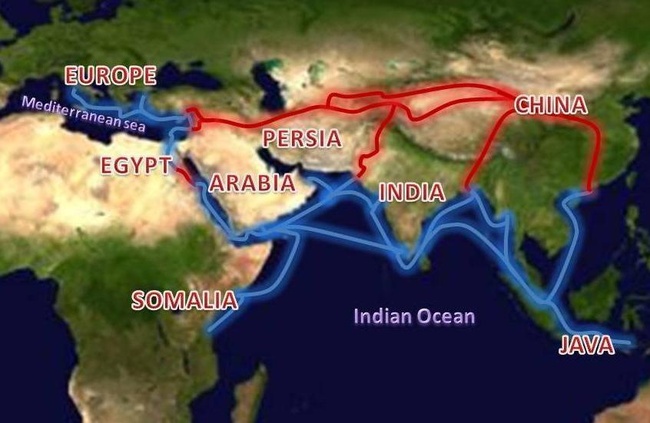
The Norse
The first Europeans to arrive in North America — at least the first for whom there is solid evidence— were Norse, traveling west from Greenland, where Erik the Red had founded a settlement around the year 985. In 1001 his son Leif is thought to have explored the northeast coast of what is now Canada and spent at least one winter there.
While Norse sagas suggest that Viking sailors explored the Atlantic coast of North America down as far as the Bahamas, such claims remain unproven. In 1963, however, the ruins of some Norse houses dating from that era were discovered at L’Anse-aux-Meadows in northern Newfoundland, thus supporting at least some of the saga claims.
![Christopher Columbus by Sebastiano del Piombo [Public domain], via Wikimedia Commons](https://www.oercommons.org/editor/images/1631)
Columbus
For more than a thousand years, people knew the world was roughly spherical. In fact, the ancient Greeks had calculated the circumference of the earth to within an accuracy of 200 miles. Still, Christopher Columbus, A Genoese sailor from an island near Italy, thought the earth a much smaller orb and reasoned that by sailing west, he could open a new trade route to China, thus eliminating both the Muslims and the voyage past the southern tip of Africa. Columbus appealed unsuccessfully to various European monarchs. Since the fall of Constantinople to Muslim forces in 1453, these monarchs had been contemplating a new crusade and did not wish to be distracted from it. When, in 1492, Muslim forces were successfully driven out of southern Spain, Queen Isabella was persuaded to invest newly freed resources in Columbus' quest.
No one expected him to return and European attention was fixed firmly on the East. When, contrary to all expectation, Columbus returned to Spain with both captives and evidence of gold, European attention suddenly, and radically, shifted west. The new crusade never got off the ground.
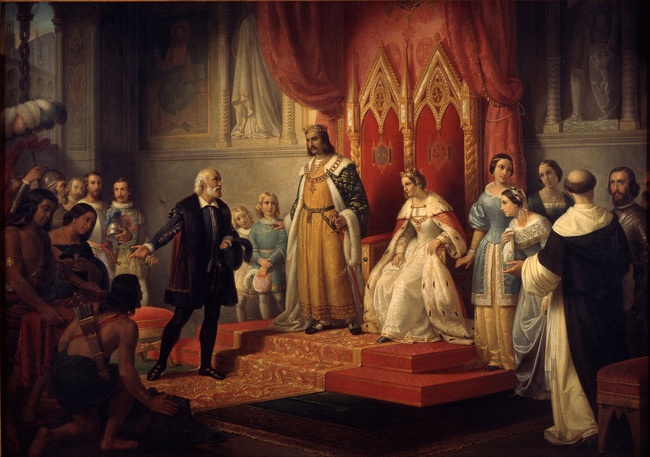
A Budding Rivalry
In 1497, just five years after Christopher Columbus landed in the Caribbean looking for a western route to Asia, a Venetian sailor named John Cabot arrived in Newfoundland on a mission for the British king. Although quickly forgotten, Cabot’s journey was later to provide the basis for British claims to North America. It also opened the way to the rich fishing grounds off George’s Banks, to which European fishermen, particularly the Portuguese, were soon making regular visits.
!["Interview of Samoset with the Pilgrims", book engraving, 1853 [Public Domain], via Wikimedia Commons](https://www.oercommons.org/editor/images/1633)
A New World
Contact with Europeans radically changed the way North Americans lived, fought, and died. North Americans had always been travelers, traders and innovators just like the rest of the human family. They adopted new methods and technologies from other tribes, feuded, made peace, and engaged in all the peculiarities known to humankind. What made contact from Europeans so unusual and disruptive was the exposure to new diseases, radically new technologies, and the sheer number of people arriving. Additionally, these new arrivals brought old rivalries with them and became embroiled in existing North American disputes.
The quick adoption of Old World weaponry would also change the way North Americans hunted and made war on each other. For their part, Europeans could merely withhold powder, shot or replacement parts to render North Americans vulnerable.
Spain
Isabella had her own reasons for supporting Columbus. In part, she was shamed into support by her advisors who claimed that if she did not attempt to find and Christianize new peoples, it would be a blemish on both her reign and her immortal soul. Additionally, the Portuguese exploration of Africa earlier in the century had resulted in both gold from, and dominance of, West African trade. Accordingly, Spain was effectively shut out of the existing sea voyage to China anyway since they could not put in at rival sea ports. When Columbus brought back both gold and ‘heathens’ from the "New World," Isabella poured herself, and Spain, into the enterprise wholeheartedly.
!["The Return of Christopher Columbus" by Eugene Delacroix [Public domain], via Wikimedia Commons](https://www.oercommons.org/editor/images/1634)
Aztecs
Spain's major influence in the New World was centered on Central America and radiated into North and South America. In 1519, Hernan Cortes brought Aztec dominance of Central America to an end when he conquered the Aztecs with the aid of his new Central American allies. These allies had long been victim to the Aztec practice of human sacrifice in which as many as 50 war captives per day had their living hearts removed.
!["The death of Moctezuma at the hands of his own people" [Public domain], via Wikimedia Commons](https://www.oercommons.org/editor/images/1635)
The combination of Spanish weaponry, European disease, and local hatreds were too much for the Aztecs who were subsequently enslaved, looted and forced into mining silver and gold to send back to Spain.
Video:(51.44) Montezuma (https://login.proxy.nmc.edu/login?url=http://fod.infobase.com/PortalPlaylists.aspx?wID=105019&xtid=41708) This video is accessible to NMC students only (login required).
![Aztec ritual human sacrifice portrayed in the page 141 (folio 70r) of the Codex Magliabechiano. [Public domain], via Wikimedia Commons](https://www.oercommons.org/editor/images/1636)
Inca
In 1531, Francisco Pizarro meted out a similar fate to the Inca. With barely a hundred soldiers and aided by local South Americans, Pizarro conquered the South American Inca, executed their leader and plundered the capital city of Cuzco. Once again, Spanish galleons were sailing to Spain filled with American gold.
!["Inca-Spanish confrontation in Cajamarca" by Lupo [Public domain], via Wikimedia Commons](https://www.oercommons.org/editor/images/1637)
Spanish North American Exploration
With the conquest of Mexico in 1522, the Spanish further solidified their position in the Western Hemisphere. The ensuing discoveries added to Europe’s knowledge of what was now named America — after the Italian Amerigo Vespucci, who wrote a widely popular account of his voyages to a “New World.” By 1529 reliable maps of the Atlantic coastline from Labrador to Tierra del Fuego had been drawn up, although it would take more than another century before hope of discovering a “Northwest Passage” to Asia would be completely abandoned.
![A map showing the proposed route of the de Soto Expedition, based on the 1997 Charles Hudson map. Herb Roe [CC BY-SA 3.0], via Wikimedia Commons](https://www.oercommons.org/editor/images/1638)
Another Spaniard, Francisco Vázquez de Coronado, set out from Mexico in 1540 in search of the mythical Seven Cities of Cibola. Coronado’s travels took him to what we now know as the Grand Canyon and Kansas, but failed to reveal the gold or treasure his men sought. However, his party did leave the peoples of the region a remarkable, if unintended, gift: Enough of his horses escaped to transform life on the Great Plains. Within a few generations, the Plains Indians had become masters of horsemanship, greatly expanding the range of their activities.
![Map of the Coronado Expedition route. Courtesy of the University of Texas Libraries, [Public Domain], via Wikimedia Commons](https://www.oercommons.org/editor/images/1639)
The Spanish System
One of Spain’s goals was to “civilize” the New World by recreating its own society there. In practice, however, Spanish society in the New World looked nothing like the Spain of the old. Separated by an ocean and thousands of miles, the political will of the king and the ecclesiastical will of the Pope were barely recognizable, and “Christian” in name only. The “Requerimiento” was a document that was read aloud (in Spanish) to the inhabitants of any newly encountered settlements. This document announced peace and protection for those choosing to submit to Spanish rule and war upon those who resisted.
Repartimiento
The Repartimiento system required each local male to work nine months of the year for the Spanish Encomendero (village commander) to build churches, roads, irrigation projects, etc. in return for eventual Spanish citizenship, protection, and church instruction and membership. Widespread abuses led Franciscan missionaries to complain loudly to both king and Pope. The Pope intervened, saying that the locals were “not animals” and could not be enslaved, nor have their property taken away. However, it was the military, not the Church, which ruled in New Spain. The abuses continued.
France
The French made halting, unsure forays into the New World for most of a century before establishing a permanent presence. Beginning in 1524, an Italian mariner was hired to explore the east coast of North America. Ten years later Jacques Cartier found the mouth of the St. Lawrence River and, in 1535, returned again and probed the river all the way to modern-day Montreal. Finally, in 1603, Samuel De Champlain established both a settlement at Montreal and trade with the Huron peoples. Unknowingly, by allying with the Huron, the French had stumbled into one of the greatest North American rivalries in history. The Iroquois, arch enemies of the Huron, had just become sworn enemies of the unwitting French.
![Map of New France, by Samuel de Champlain, 1612, [Public domain], via Wikimedia Commons.](https://www.oercommons.org/editor/images/1640)
Following the collapse of their first Quebec colony in the 1540s, French Huguenots attempted to settle the northern coast of Florida two decades later. The Spanish, viewing the French as a threat to their trade route along the Gulf Stream, destroyed the colony in 1565. The leader of the Spanish forces, Pedro Menéndez, would soon establish a town not far away — St. Augustine. It was the first permanent European settlement in what would become the United States.
Footprint
The French tended to leave less of a footprint on the land and culture than the Spanish before them and the English after them. Because there was no gold to mine, there was no compelling reason to enslave North Americans. Because they were so far north, the climate did not lend itself to farming as a large-scale alternative, hence, again, no forced labor would be imposed on the locals. Also the gathering of fur was done on a much greater scale when others willingly joined the cause and stood to benefit from it. Finally, cutting down the forests to build large settlements and farms would destroy fur habitat.
The French found that by working more or less in harmony with the pre-existing population, adapting some of their ways and engaging in a free cultural and economic exchange, their purposes were better served.
Influence
The French left an indelible cultural mark in North America through religion and their mere presence. The French, also Catholic like Spain, brought missions and missionaries to New France. The Jesuits showed an uncommon patience and sensitivity in learning indigenous ways and—to the extent that these didn’t conflict with the Faith—adopting those ways. As their religion was generally not forced upon the North Americans, it was also slower taking hold.
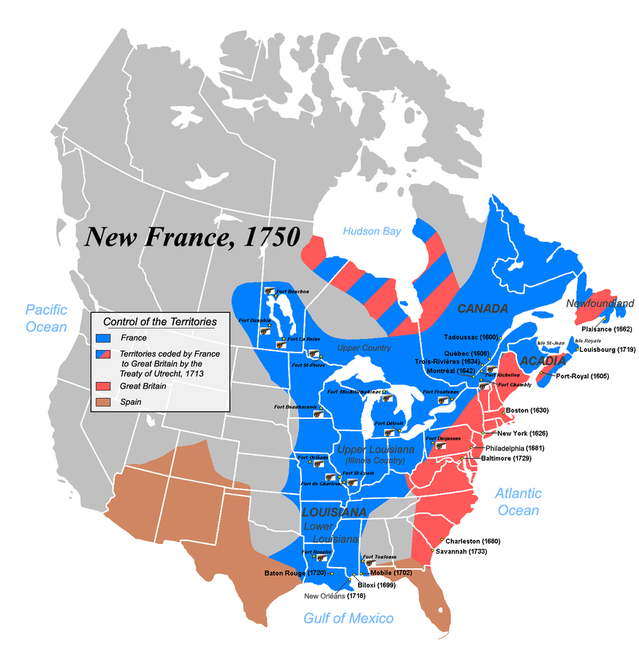
Likewise, the French traders intermarried with North Americans, thereby forging alliances between families and nations. Geographically, the French would, by 1700, control the Great Lakes area, New Orleans and much of the vast Mississippi River which connected the two regions.
The French System
The French, along with the English, Dutch and other Europeans, had long envied the wealth being brought back in Spanish galleons. Nonetheless, they quickly realized that no treasure trove of gold awaited them in their chosen sphere of influence in the New World. What the Great Lakes area did offer was fur. Beaver hats were quite popular in Europe and the French had the added advantage that they were the fashion trend-setters of Europe. The French began trading weapons, iron tools, kettles and various wares to the Huron. The Huron, in turn, supplied furs. In fact, the Huron began trading with interior tribes to obtain more furs and the continent began to bleed fur into the Saint Lawrence River Valley, across the Atlantic and into Europe. Once in Europe, the furs were made into hats and traded for Spanish gold which had been the ultimate goal in the first place.
Video (00:05:59) Fort Michilimacinac (https://ensemble.nmc.edu/Watch/Kx75Bsg3)
England Enters the Race
![Roman Empire 1st Century A.D. [Public Domain], from Historical Atlas, by Robert H. Labberton, 1884.](https://www.oercommons.org/editor/images/1642)
To understand the reasons and motivations behind English colonization in North America we must step back once again to 330 AD. Because the Roman Empire was imploding upon itself, the Emperor Constantine moved the capital of Rome east to Constantinople where the most lucrative trade was. This left the western (European) half of the Mediterranean subject to lawlessness, piracy, barbarian—and, eventually—Muslim invasion. Accordingly, the city of Rome lost imperial protection as did the rest of Italy, as well as what would eventually become France, Germany, Spain and England. Each was left to their own devices. Without the protection of the Roman military, coastal Mediterranean cities—under constant threat of pirate raids—emptied into the interior of Europe where most people organized themselves under the most promising looking local strongmen in return for protection.
Nation States
It was competition between these local strongmen which resulted in the development of European nation states. The earliest of these was probably Charlemagne in France during the 8th century but other "nobles" and "lords" were establishing themselves throughout Europe during this "feudal" period. In 1066, the French Duke of Normandy sought to expand his personal empire and crossed the English Channel. He then conducted the only successful conquest of England in history.
!["Growth of Frankish Power, 481-814." [Public domain], from The Historical Atlas by William R. Shepherd, 1923.](https://www.oercommons.org/editor/images/1643)
The question immediately arose as to whether the French Duke of Normandy had just expanded his territory, hence, that of the French king, or whether he had done something entirely different altogether. When the king of France demanded the duke's loyalty, the duke responded by declaring himself king of England...and Normandy. What followed became perhaps the greatest, longest-running, national rivalry in the history of the planet.
Magna Carta
During the Crusades—which had begun within a half-century following the Norman invasion—the king of England (Richard Lion-Heart) had led an army to the Holy Land, leaving his brother John to rule in his stead. John was an inept ruler and, once Richard died, became king in his own right. Through a series of political and military blunders, John lost Normandy and its considerable income to the king of France. To make up for the lost income, John imposed new and increased taxation upon the English nobility.
!["John of England signs Magna Carta." [Public domain], from Cassell's History of England, ca. 1902, scan by Tagishsimon [Public domain], from Wikimedia Commons](https://www.oercommons.org/editor/images/1644)
"John of England signs Magna Carta." [Public domain], from Cassell's History of England, ca. 1902, [Public domain], via Wikimedia Commons
After a failed dispute with the Catholic Church, John even signed over England itself to the Church and rented it back for a yearly fee. The nobility had seen enough, invaded London and forced John to sign the Magna Carta in 1215.
The Magna Carta directly influenced the establishment of the English Parliament, whose purpose was to advise, and potentially overrule, the king; it also protected English subjects from unlawful arrest. John had no intention of honoring Magna Carta once the nobles left town. However, his unexpected death the next year brought his nine year old son, Henry III, to the throne and the Nobility correctly surmised that they would be able to influence, if not control, Henry. Henry reigned in England for more than a half century during which time he reaffirmed Magna Carta several times, thereby making the limited monarchy an immovable fixture in England and creating the conditions for modern western democracy.
![The 1225 version of Magna Carta issued by Henry III of England. This copy is in the National Archives (London), DL 10/71. [Public domain], via Wikimedia Commons](https://www.oercommons.org/editor/images/1645)
Video: Magna Carta 00:9:30 (http://digital.films.com.proxy.nmc.edu/play/KWFJVJ&sa=D&ust=1462826944933000&usg=AFQjCNHDmBNW4MQNDpZojBmcaaCEQLPxRQ) This video is accessible to NMC students only (login required).
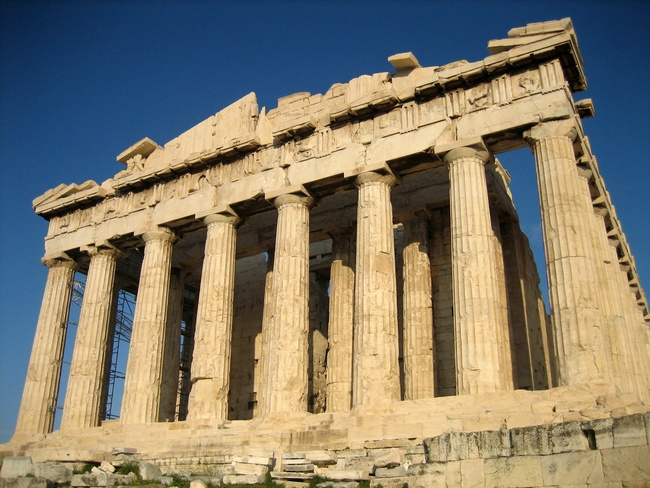
The Parthenon of ancient Greece. By User:Mountain - Own work, Public Domain, via Wikimedia commons
Renaissance
Ever since the fall of Rome in the 4th century, Europeans had looked nostalgically back to the time when "civilization" flourished, as opposed to "these dark times." Even when Constantine had moved the capital so many years before it was with the hope that the former glory of Rome would one day be restored and the empire (East and West) reunited. The Renaissance or "Rebirth" in the 14th through 17th centuries was a time when many Europeans stopped looking back to ancient Greece and Rome and began looking ahead. They actually began to imagine surpassing the classical era as the pinnacle of civilization.
Renaissance artists created greater sculptures than had the Greeks and Romans; Renaissance architects built more magnificent buildings than the Greeks and Romans, literary criticism revived, revered and challenged ancient writing, and philosophy was born anew. The most profound change, however, would come in the form of religion.
![Raphael's "School of Athens" [Public domain], via Wikimedia Commons](https://www.oercommons.org/editor/images/1647)
Reformation
In the midst of the Renaissance, and only decades after Columbus' unlikely return from the New World, a religious revolution shook and divided Europe, plunging it into war for over a century. A technological marvel was largely to blame. In 1450, a German goldsmith-Johannes Gutenberg-invented the first moveable type printing press. The printing press multiplied vastly the number of books available to Renaissance Europeans. Books on science, trade and literature all fueled and enhanced the Renaissance and its penchant for thoughtful criticism of ancient texts. Most influential was the multiplication of bibles and other religious works.
!["Invention of printing - Gutenberg taking the first proof," [Public domain], via Library of Congress.](https://www.oercommons.org/editor/images/1648)
![Portrait of Martin Luther by Lucas Cranach the Elder [Public domain], via Wikimedia Commons](https://www.oercommons.org/editor/images/1649)
Martin Luther
A German-Catholic monk named Martin Luther was just one of a growing number of priests who now had access to the scriptures. Prior to the printing press, only hand copied bibles were available and they were closely guarded. In the 1500 years since the birth of Christ, the Church had become the key institution uniting Europeans of different languages and nationalities into one common religion. Both the inability and unwillingness of the Church to make scripture widely available prior to printing press technology left an accountability gap in which few could or would compare the practices and traditions of the Church to the scriptures which those practices were supposed to be based upon. In 1517, sixty-seven years after the first printing press, Martin Luther did just that --tacking 95 different theses (theological complaints in this case) to the door of the cathedral in Wittenberg.
Complaints
Luther was particularly vexed by two related issues—works and indulgences. According to the biblical books of Galatians and Romans, Luther argued, it is "faith alone" which saves. There was, according to Luther, no work that can earn one's place in heaven. The Pope of that day, Leo X, was in the midst of a money raising campaign to build Saint Peter's basilica. He had recently commissioned John Tetzel to sell "indulgences" far and wide to raise money for the project. An indulgence was a prime example of "works." The idea was that one's suffering for the cause of Christ could earn a soul's freedom from Purgatory and entry into Heaven.
![A Roman Catholic certificate of having gone to confession from the year 1521. By Fr. Jeronimus Munghofer, OB [Public domain], via Wikimedia Commons](https://www.oercommons.org/editor/images/1650)
This is an english translation of an Indulgence
I, brother Jeronimus Munghofer of the Order of St. Benedict, confessor and penitencer of the monastery and chapel of St. Mary the Virgin consecrated in the diocese of Constance, recognize the penitences made by Brothers Johann and Oswald Burgi and that they have visited the said place and chapel, and submitted their petition according to the form of the Church, and I, by the authority granted to me by the Holy See, absolve them of their penance, and in witness thereof I have granted them these letters and sealed them according to custom. In the year 1521, on the nineteenth day of December. St. Peter's Basillica
If, for example, one were to build a rock wall for Christ, that would amount to suffering for Christ. If one were to build a rock wall for wages and turn the wages over to Christ (the Church) by purchasing an indulgence, this would be reckoned as equivalent suffering. Reams of indulgences were printed (on presses) and sold to the citizenry. Luther seethed.
![John Calvin, by Georg Osterwald (1803–1884) [Public domain], via Wikimedia Commons](https://www.oercommons.org/editor/images/1651)
Consequences
Attempts to quiet Luther only incensed him further. He was even offered a cardinalship with the very real possibility of becoming Pope himself. Luther brushed this off as a bribe and (in protest) broke with the Church. The German princes protected Luther out of conscience and/or personal gain (no more church taxes to Rome). Once this dam broke, there was no rebuilding it. Other reformers like Jean Calvin began criticizing the Church (and each other) as having wrongly interpreted and applied scripture. Catholic lords warred against Protestant lords in a contest to determine which brand of "The Faith" would represent various regions and nations. A multitude of Protestant churches would result within a few decades.
Video: Martin Luther 00:24:00
(http://digital.films.com.proxy.nmc.edu/play/2FDGWT&sa=D&ust=1462826944940000&usg=AFQjCNHggS1WQRdD29FrXyNI3ZRtUed_ew) This video is accessible to NMC students only (login required).
Henry VIII
Annoyed by the Pope's delay in approving his request for a divorce from Catherine of Aragon, Henry VIII also broke with the Catholic Church in 1533 and established the Church of England (Anglican Church). In order to side-step rebellion from his nobles, Henry confiscated all Church property and distributed much of it to them. England's church was now officially, if somewhat shakily, "Protestant" and Henry was its head. This new "Anglican" Church was Protestant in name only. Henry was no idealist and had no particular beef with the way church was done. Hence, the coming of Protestantism to the British Isles was a mere convenience for Henry, rather than real reform; the liturgy remained virtually unchanged.
![Portrait of Henry VIII. Hans Holbein the Younger (1497/1498–1543) [Public domain], via Wikimedia Commons](https://www.oercommons.org/editor/images/1652)
Tossed About
Upon Henry's death in 1547, his son, Edward VI, moved England sharply toward "real" protestant reform. Catholic dissenters were persecuted and the Anglican Book of Common Prayer was forced upon all local congregations. Within five years the sickly Edward had died and (Bloody) Mary I, Henry's daughter by Catherine of Aragon, had taken power and drove England back toward Catholicism. For the next four years, Protestants were imprisoned, executed or driven into exile.
![Queen Mary Tudor of England and Edward VI of England, [Public domain], via Wikimedia Commons](https://www.oercommons.org/editor/images/1653)
Elizabeth
![Queen Elizabeth I, [Public domain], via Wikimedia Commons](https://www.oercommons.org/editor/images/1654)
When Mary died in 1558, her sister Elizabeth cautiously urged England back toward Protestantism for the nearly half-century of her reign. From this point onward, England would remain a Protestant nation, though not without several Catholic challenges. Increasingly, the English perspective was that the New World was "falling" to Catholicism through the depredations of Spain and France. In the process they were enriching themselves, thus strengthening their nations which were bastions of Catholic power. Given the situation, the English wondered: "should not England also establish a presence in the New World?"
!["Coronado sets out to the North." Frederic Remington [Public domain], via Wikimedia Commons](https://www.oercommons.org/editor/images/1655)
Landfall
Englishman Francis Drake’s successful raids on Spanish treasure ships, only intensified English interest in the New World and in 1578 Humphrey Gilbert, the author of a treatise on the search for a Northwest Passage, received a patent from Queen Elizabeth to colonize the “heathen and barbarous landes” in the New World that other European nations had not yet claimed. It would be five years before his efforts could begin. When he was lost at sea, his half-brother, Walter Raleigh, took up the mission.
In 1585 Raleigh established the first British colony in North America, on Roanoke Island off the coast of North Carolina. It was later abandoned, and a second effort two years later also proved a failure. It would be 20 years before the British would try again. This time — at Jamestown in 1607 — the colony would succeed, and North America would enter a new era.
________________________________________________________________________